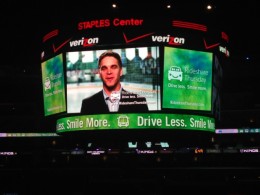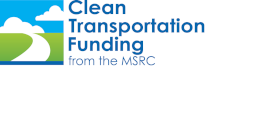 The MSRC recently took to the airwaves (and the internet) with an innovative and aggressively marketed Rideshare Thursday campaign that reached millions of people who live, work and commute throughout the South Coast Air District. To date, the campaign has generated more than 264 million impressions– meaning the number of times the message was seen or heard across the target audience of commuters throughout the campaign. Fraser Communications, the firm which developed and directed the campaign for the MSRC, understands how important repeated exposure to a message is toward creating lasting change.
The MSRC recently took to the airwaves (and the internet) with an innovative and aggressively marketed Rideshare Thursday campaign that reached millions of people who live, work and commute throughout the South Coast Air District. To date, the campaign has generated more than 264 million impressions– meaning the number of times the message was seen or heard across the target audience of commuters throughout the campaign. Fraser Communications, the firm which developed and directed the campaign for the MSRC, understands how important repeated exposure to a message is toward creating lasting change.
“Fraser has a track record of working on campaigns that help educate people to change their behavior for the better,” explained Ilene Prince, Senior Vice President and Director of Client Services for Fraser. “A campaign needs to have a large amount of impressions because the first time a person hears a message it doesn’t always sink in. In fact, there’s a statistic that the average person needs to hear a new message three to five times before it even becomes part of their awareness set. This is why for the rideshare campaign it was important to have enough impressions so by the third or fourth time a person heard it, they’d say ‘oh, that’s the rideshare spot.’”
“The Rideshare Thursday concept was first introduced by Caltrans in the mid-1990s and was so successful, that it remains a part of our Southern California commuter culture,” commented Steve Veres, Vice Chair of the MSRC. “Many commuters recognize this slogan and it is still used by traffic reporters. Since Thursday typically sees more commuters on the road than any other day of the week, it makes sense to reinforce the alternative transportation options available to help ease congestion on Thursdays (and other days of the week too). The MSRC wanted to capitalize on the Rideshare Thursday brand recognition and reintroduce the campaign to drivers to raise more awareness that we hope will increase rideshare participation.”
The Rideshare Thursday campaign launched in September 2013. The campaign’s first phase was created to raise broad awareness, which was done through radio spots, digital ads and social media. The catchy thirty-second radio spots (available on the MSRC’s website ran on nine top Clear Channel FM and AM stations, along with fifteen second radio traffic spots. The radio buy also included additional top English, Spanish and Asian language stations. The online platforms included Pandora, iHeart Radio and CBS Radio. The digital media ads had catchy slogans such as, “Drive Less.Smile More.” “diamond lanes are a girl’s best friend,” and “less gas money = more lunch money.” The radio and digital spots were designed to drive people to the RideshareThursday.com website and Facebook page (Facebook/RideshareThursday) where they could get more information about how to rideshare.
This successful phase of the campaign was complemented with a contest to tout the benefits of ridesharing and remind people that if they were not in their cars, they would have more time to do other activities. People participated in the contest by going to the Rideshare Thursday Facebook page, where they ‘liked’ the page to join the contest and take a “share your ride” quiz. More than two thousand people participated with about 150 prizes awarded. The prizes included iPads, bicycles, and music and book gift cards which were selected carefully to be things that people could use in their newly found free time while ridesharing. The contest helped increase significantly the number of followers on Facebook where rideshare tips and best practices are regularly updated, and followers are able to easily share these posts with their friends which further disseminates the rideshare message.
The goal of honing in on these types of broad reaching media was to pique people’s interest to seed the notion of ridesharing, so they would be ready for the second phase of the campaign. This phase, which wrapped up at the end of last year, was hyper-targeted to reach audiences when they were most receptive to the rideshare messaging. This included a unique partnership with the Los Angeles Kings.
 The partnership with the Kings seemed like a natural fit and the perfect audience to target because the Metro station is located right behind the Staples Center, noted Ilene. Fraser was looking for an opportunity to reach a large group of people who attend these types of big events to show them there is an easier way to get there than by car.
The partnership with the Kings seemed like a natural fit and the perfect audience to target because the Metro station is located right behind the Staples Center, noted Ilene. Fraser was looking for an opportunity to reach a large group of people who attend these types of big events to show them there is an easier way to get there than by car.
The Kings filmed a PSA featuring Luc Robitaille, former Kings player, Hall of Famer, and current President of Business Operations, sharing the ridesharing message, which was run before all regular season home games on the stadium’s JumboTron and is on the Kings Vision website (http://video.kings.nhl.com/videocenter/console?catid=731&id=456806&lang=en). There also were two special Rideshare Thursday ‘blitz’ nights - one in November and one in December - that kicked-off with the song “C’mon N’Ride It (The Train)” accompanied by a video on the JumboTron showing the LA Kings’ Ice Crew and the team’s mascot Bailey coming off the Metro train and running into the stadium. Then, the Ice Crew ‘flash mob’ ran into the stands to hand out 100 Metro TAP (Transit Access Pass) cards to the fans. They even selected two people to receive seat upgrades for the two games. Throughout these games, the campaign’s message was displayed on the JumboTron as well as the screens that circle the stadium.
“The Kings gave us probably ten times the amount of coverage above and beyond what we paid for because they were really behind the ridesharing message. It turned out to be a very fruitful partnership,” Ilene said.
Even though the official paid advertising campaign has concluded, the Facebook page has been so successful that it will continue. The page has more than 6,500 ‘likes’ and continues to grow each week.
According to Ilene, the need for these types of campaigns is important because it raises awareness that change can happen even by doing little things differently. “For example, expanding the idea of Rideshare Thursday to rideshare any day opens up the possibility that if you can get someone to try it once and they see how easy it is, it starts to integrate in their behavior. Things that maybe they didn’t think of can start the change and then people embrace it. Campaigns like Rideshare Thursday serve as eye-openers, or as a way to at least get the conversation started. So, even if we just got the conversation started about ridesharing, we are further down the road than we were.”
Ilene says that the Rideshare Thursday campaign has been a success. “We feel really confident that we got the conversation started and that, through our messaging, we had a lot of people investigate ridesharing options, or at least consider ridesharing options. We feel like the campaign opened the door for people to consider ridesharing.”
